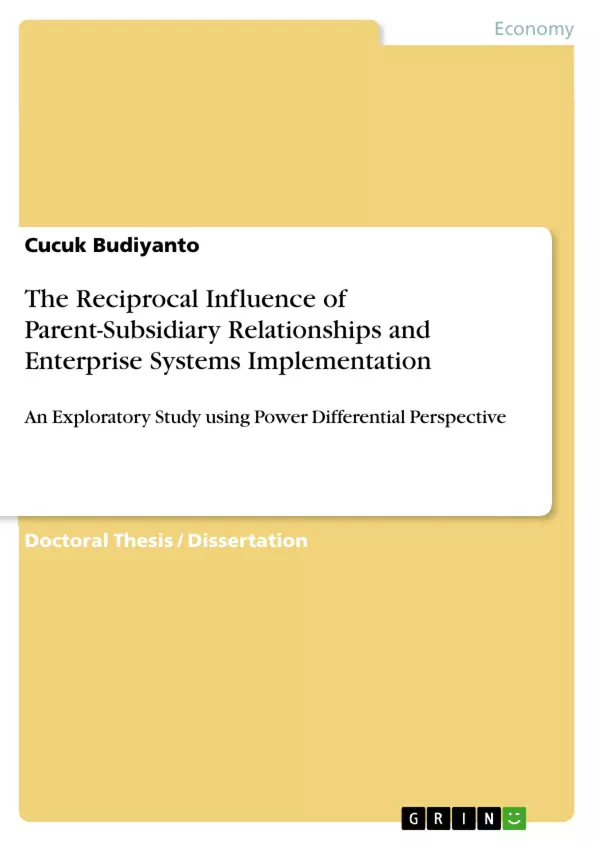This research focuses on the investigation of the reciprocal influence between the relationships of parent and subsidiary company of corporate groups and the implementation of the Enterprise Systems in subsidiary company. Pertinent to the exploration is how power differential being transpired in the relationships between a holding and subsidiary company of corporate groups during the implementation of Enterprise Systems.
The literature on corporate groups indicates that the relationships between holding and subsidiary companies in the corporate groups are ingrained with power that is associated with the authority, control, and the ability to influence. The aim of this research is to investigate the key aspects of the relationship between parent and subsidiary companies in corporate groups and their impacts on organisation’s Enterprise Systems adoption and implementation. This research also anticipated Enterprise Systems to be one aspect that drives the change in the relationship between parent and subsidiary company.
An interpretive paradigm is the assumed philosophical stance in this research. The case study research method with embedded cases was chosen as the main research approach. Two case studies with five embedded cases were explored. The participating corporate groups were a privately-owned corporate group and a state-owned corporate group in Indonesia. Semi-structured interviews were used for data collection and qualitative content analysis technique was used in analysing the interview data.
The outcome of the investigation demonstrates three aspects in the relationships between a parent and subsidiary company of corporate groups during the implementation of Enterprise Systems that may be beneficiary for practitioners and researchers interested in the use of IS/IT (particularly in developing countries). The holding company should consider the individual business requirements and the “uniqueness” of the subsidiary company in issuing directives for the implementation of Enterprise Systems in subsidiary companies. The second aspect underlines the importance of the holding company to provide strategic directives to achieve the corporate group vision while facilitating and/or enabling the achievement of the subsidiary’s own business objectives. The third emphasises on the importance of the communication between corporate group members, particularly in the design and implementation of the appropriate Enterprise Systems.
Table of Contents
- Abstract
- Acknowledgements
- Declaration
Objectives and Key Themes
This research investigates the reciprocal influence between parent-subsidiary relationships in corporate groups and the implementation of Enterprise Systems in subsidiary companies. It explores how power differentials within these relationships impact Enterprise Systems implementation. The study aims to identify key aspects of parent-subsidiary relationships and their influence on Enterprise Systems adoption and implementation, also considering how Enterprise Systems might influence the parent-subsidiary relationship.
- The impact of power differentials in parent-subsidiary relationships on Enterprise Systems implementation.
- The influence of parent company directives on subsidiary company Enterprise Systems adoption.
- The role of communication in the design and implementation of Enterprise Systems within corporate groups.
- The consideration of individual subsidiary business requirements during Enterprise Systems implementation.
- Balancing corporate group vision with subsidiary company objectives in Enterprise Systems implementation.
Chapter Summaries
Abstract: This research explores the reciprocal relationship between parent and subsidiary companies in corporate groups and Enterprise Systems implementation in subsidiaries. It examines the power dynamics involved and aims to understand how these relationships influence and are influenced by technology adoption. The study uses a qualitative approach with case studies in Indonesian corporate groups, investigating how holding companies should balance corporate-wide directives with individual subsidiary needs. The findings highlight the necessity of considering subsidiary uniqueness, providing strategic direction while facilitating subsidiary objectives, and emphasizing effective communication across the corporate group.
Keywords
Parent-subsidiary relationships, Enterprise Systems implementation, power differential, corporate groups, case study, qualitative research, Indonesia, organizational change, information systems, technology adoption.
Frequently Asked Questions: A Research Preview on Parent-Subsidiary Relationships and Enterprise Systems Implementation
What is the main focus of this research?
This research investigates the reciprocal relationship between parent-subsidiary relationships within corporate groups and the implementation of Enterprise Systems in subsidiary companies. It specifically examines how power dynamics within these relationships impact the adoption and implementation of these systems.
What are the key themes explored in this research?
Key themes include the impact of power differentials on Enterprise Systems implementation, the influence of parent company directives on subsidiary adoption, the role of communication in the design and implementation process, the consideration of individual subsidiary needs, and balancing corporate-wide vision with subsidiary objectives.
What methodology is used in this research?
The research employs a qualitative approach, utilizing case studies within Indonesian corporate groups to gain in-depth understanding of the complexities involved.
What are the key findings previewed in this document?
The preview highlights the crucial need to consider the unique characteristics of each subsidiary, to provide strategic direction while allowing for subsidiary-specific objectives, and to prioritize effective communication throughout the corporate group during Enterprise Systems implementation.
What are the key words associated with this research?
Key words include: Parent-subsidiary relationships, Enterprise Systems implementation, power differential, corporate groups, case study, qualitative research, Indonesia, organizational change, information systems, technology adoption.
What is included in this preview?
This preview offers a comprehensive overview including the title, table of contents, objectives and key themes, chapter summaries, and keywords.
What is the scope of the research regarding geographical location?
The research focuses on Indonesian corporate groups, using case studies within this specific context.
What is the overall goal of this research?
The research aims to understand how parent-subsidiary relationships influence and are influenced by Enterprise Systems implementation, providing insights into best practices for successful technology adoption within complex corporate structures.
- Quote paper
- Cucuk Budiyanto (Author), 2016, The Reciprocal Influence of Parent-Subsidiary Relationships and Enterprise Systems Implementation, Munich, GRIN Verlag, https://www.grin.com/document/383736



